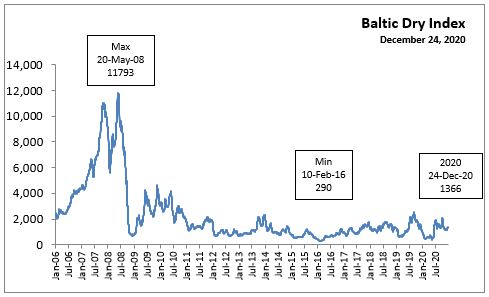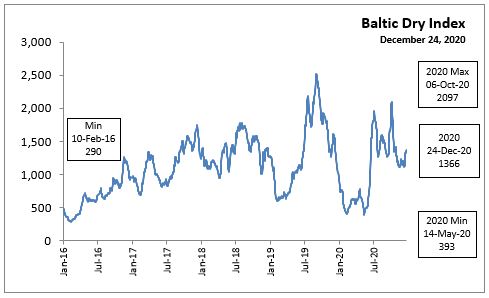The Economics and Statistics Division maintains archives of previous publications for accountability purposes, but makes no updates to keep these documents current with the latest data revisions from Statistics Canada. As a result, information in older documents may not be accurate. Please exercise caution when referring to older documents. For the latest information and historical data, please contact the individual listed to the right.
<--- Return to Archive
For additional information relating to this article, please contact:
January 11, 2021BALTIC DRY INDEX DECEMBER 2020 The BDI measures procurement costs of shipping raw materials by sea. When these costs go down, producers benefit from increased margins, and consumers benefit from lower prices for finished products.

On May 20, 2008, the Baltic Exchange reported the BDI = 11,793 a new high for the index. Before the year was out, the BDI dropped to 663 on 5 December 2008.
On February 10, 2016, the Baltic Exchange reported the BDI = 290 a new low for the index. When the index drops below 500, shipping companies tend to idle their fleets as variable costs cannot be recovered.
On the last trading day in 2020, the Baltic Exchange reported the BDI = 1,366, an increase of 1,076 points over February 10, 2016.
Recent Activity to December 24, 2020
- February 11, 2019 the BDI had reached a recent low of 595
- by September 4, 2019, the BDI had increased steadily to 2518
- by May 14, 2020, Covid 19 and high oil prices resulted in the BDI declining to a new recent low of 393
- by October 6, 2020, massive stimulus by China to restart the economy, and the reduction of oill prices resulted in the BDI rebounding to 2097
- since the begining of October the BDI has settled to 1366

QUOTES
"The Baltic Dry Index has dropped to its lowest point in four years time as a result of the coronavirus
The last time the Baltic Dry Index dove below 500 points was in February 2016, arguably the toughest year for shipping since the start of the millennium."
https://www.projectcargojournal.com/shipping/2020/02/04/coronavirus-and-imo2020-send-baltic-dry-index-crashing-down/
THE BALTIC DRY INDEX RESURGES AS CHINA’S DEMAND FOR IRON ORE PICKS UP
"The onset of the coronavirus pandemic in the first half of the year resulted in a steep decline in global trade as economies came to a literal standstill leading to a commensurate drop in the Baltic Dry Index (BDI). With the gradual return of economic activities in 2Q2020 and boosted by a remarkable turnaround in China, the Baltic Dry Index (BDI) has peaked over 2,000 points in October, rebounding to September 2019 levels, having recovered from the dismal levels in May of 393 points.
China has enacted a massive stimulus to restart the economy worth estimated at more than USD 500 billion by embarking on what can only be described as a major infrastructure push from green energy projects to electrical grids and airports, resembling the approach used in the last global recession.
The lowest level this year was recorded by the height of the pandemic, on May 14, when it fell to 393 points, amid low bulk shipping prices due to global lockdowns and depressed demand. The rebound, however, was quick. About one month later, on June 16 it had already crossed 1,000 points."
https://www.cwgrp.com/in-depth-analysis/530379-the-baltic-dry-index-resurges-as-china-s-demand-for-iron-ore-picks-up
REFERENCES
The Surprising Relevance of the Baltic Dry Index, New Yorker, June 22, 2016
LLYod Baltic Dry
CNBC (one year+)
Baltic Dry Index Commodities
Bloomberg (interative chart) CLICK ON FULL VIEW CHART, then SELECT DATE RANGE
Baltic Dry Index - BDI (BALDRY), wikinvest
The Shipping News
The Baltic Exchange
<--- Return to Archive